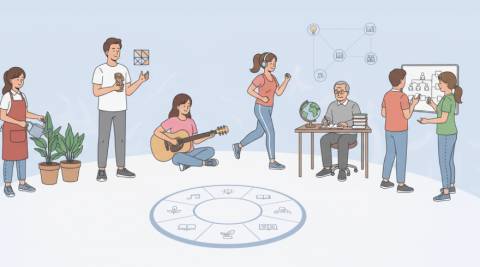Your Guide to Multiple Intelligences: Methods, Benefits, and Smarter Learning Paths

Understanding the Multiple Intelligences Framework
Multiple intelligences is a nuanced lens for understanding human potential, originally proposed by Howard Gardner. Instead of ranking people along a single standardized scale, this framework recognizes distinct domains like linguistic, logical-mathematical, spatial, bodily-kinesthetic, musical, interpersonal, intrapersonal, and naturalist. That richer view helps learners see strengths that conventional testing often overlooks, and it encourages educators to expand the range of teaching strategies they deploy in the classroom. The outcome is a more inclusive way to nurture talent and design learning that actually sticks.
Many readers want a quick snapshot before committing to a deep learning plan, and a free multiple intelligence test can provide an accessible starting point for reflection and conversation. While no brief assessment can capture your entire cognitive landscape, the results often spark curiosity, highlight overlooked capabilities, and point to growth opportunities in study techniques or career exploration. Interpreting the profile through examples, like how you solve problems, remember directions, or thrive in teams, converts abstract labels into real-world implications. That’s where this model shines: it invites action.
- It celebrates diverse strengths without forcing comparisons.
- It supports differentiated instruction and personalized study plans.
- It encourages career development aligned with authentic talents.
As you read, keep in mind that development is dynamic. Experience, coaching, and deliberate practice can elevate underused abilities over time. Treat the model as a navigation system, not a destination.
How a Modern Mi Assessment Works
Today’s online assessments blend clear, plain-language prompts with psychometric safeguards to reduce bias and guesswork. You’ll typically rate statements about preferences and behaviors across contexts: how you learn new software, explain a concept to a friend, or remember a route in a new city. The best tools balance brevity with coverage, capturing enough data points to estimate patterns without exhausting the test-taker. Some platforms even incorporate adaptive branching, asking more about areas where your answers vary most.
A number of reputable platforms host a multiple intelligences test free of charge with practical summaries and simple visuals for interpretation. Look for assessments that disclose their methodology, clarify how scores are calculated, and offer guidance on what to do next. Reliable tools separate result reporting from upsells and avoid manipulative design that pressures you to buy add-ons. If possible, choose versions that provide examples of study habits or workplace tasks aligned to each intelligence, so your next steps are concrete.
Use the quick reference below to connect each domain to strategies you can try this week. A single glance can help you choose the first experiment worth running before you dive into a larger plan.
| Intelligence | Typical Strengths | Actionable Study Moves |
|---|---|---|
| Linguistic | Wordplay, storytelling, persuasive writing | Summarize lessons aloud; build concept glossaries |
| Logical-Mathematical | Patterning, quant reasoning, systems thinking | Turn topics into flowcharts; practice with problem sets |
| Spatial | Mental rotation, visual mapping, design sense | Create mind maps; sketch diagrams from memory |
| Bodily-Kinesthetic | Hands-on learning, coordination, prototyping | Act out processes; study while walking with cues |
| Musical | Rhythm, pitch, auditory pattern recognition | Use mnemonics with beats; study to structured playlists |
| Interpersonal | Collaboration, empathy, facilitation | Teach a peer; schedule group problem-solving sessions |
| Intrapersonal | Self-knowledge, reflection, goal setting | Journal learning checkpoints; set outcome metrics |
| Naturalist | Classification, observation, real-world patterns | Use field notes; relate concepts to ecosystems |
Benefits for Learners, Teachers, and Teams
One of the biggest wins from a multiple intelligences approach is psychological safety. When students and professionals see that strengths come in varied flavors, they stop treating a single score as destiny and start designing experiences that unlock momentum. In the classroom, that might mean rotating project formats, debates, prototypes, storyboards, data analyses, so everyone gets a turn on home turf. In the workplace, managers can diversify meeting formats and training channels to reduce friction and increase knowledge transfer.
When budgets are tight and time is limited, you can still gather meaningful insights through a multiple intelligence test for free from respected education providers online. The payback shows up in better study strategies, more relevant practice, and improved self-advocacy. People who understand their preferred modes tend to retain material longer, adopt strategies faster, and experience less frustration during difficult tasks. For teams, the ripple effects include clearer role alignment, more inclusive collaboration, and fewer bottlenecks caused by mismatched work styles.
- Boosts motivation by highlighting genuine strengths.
- Guides coaching and mentorship with concrete habits.
- Improves project outcomes via complementary skill mapping.
Ultimately, the framework doesn’t pigeonhole; it widens the set of knobs you can turn to make progress feel attainable and sustainable.
Interpreting Results and Taking Action
Numbers and charts are only the beginning; the real value appears when you translate insights into specific behaviors. Start by picking one domain you’d like to leverage more, then choose one tactic from the earlier quick reference and commit to a two-week experiment. Track outcomes with brief daily notes: What felt easier? Where did you stall? What’s the smallest tweak you could make tomorrow? Micro-iterations compound and reveal which study methods are worth scaling.
If you prefer to pressure-test your insights before a big exam or a project sprint, consider piloting a new method and re-evaluating with a multiple intelligence test free option afterwards to gauge whether the change aligned with your tendencies. Avoid fixating on rank-order; instead, watch for combinations that are especially potent, say, coupling spatial techniques with interpersonal discussion to reinforce complex concepts. Over time, your toolkit becomes a personalized playbook you can adapt to new challenges without reinventing the wheel.
- Translate labels into behaviors you can schedule on a calendar.
- Use simple metrics like recall time, error rates, and confidence scores.
- Retire tactics that don’t outperform your baseline after a fair trial.
Choosing a Reliable Online Assessment
With plenty of options on the web, selection criteria matter. Credible assessments explain their purpose, offer transparent scoring, and provide clear next steps instead of vague generalities. Thorough questionnaires avoid leading language and keep readability accessible for a wide audience. Helpful reports include examples you can apply immediately, rather than generic summaries that fade once you close the browser tab. Privacy policies should be straightforward and data practices respectful.
Transparency is especially important when you pick an intelligence type test free because you want to know how your responses are used and how long the data is stored. Before starting, scan for contact information, author credentials, and revision histories that indicate ongoing maintenance. Seek platforms that separate educational content from promotional hype, and avoid tools that gate your results behind unnecessary sign-ups. Finally, confirm mobile compatibility so you can complete the assessment comfortably on any device without losing fidelity or context.
- Look for clear scoring rubrics and interpretation guides.
- Prefer platforms with documented updates and support channels.
- Check accessibility features like keyboard navigation and contrast.
Case Examples and Practical Scenarios
Consider a student who loves making diagrams but struggles with formula-heavy lectures. By reformatting notes into timelines and schematic sketches, retention improved and test anxiety decreased. Another learner realized they remember material best when discussing it with peers; switching to brief daily debriefs turned cramming into consistent progress. In a team setting, a project lead mapped tasks to strengths, giving the pattern-spotter the analytics, the storyteller the stakeholder updates, and the builder the prototype lab, velocity jumped without adding hours.
A university orientation program ran a free multiple intelligences test across first-year cohorts to tailor study-skills workshops that matched emerging profiles. Participants reported higher engagement, and advisors used the aggregate insights to diversify support services, from peer-led seminars to hands-on maker sessions. In community learning hubs, facilitators use small-group rotations so each participant can approach the same concept through words, visuals, movement, and sound. These practical shifts turn theory into traction, proving that better alignment can be both simple and powerful.
- Reformat content into the modality that clicks fastest for you.
- Rotate collaboration styles to surface complementary strengths.
- Pilot one change at a time to isolate what truly works.
FAQ: Common Questions About Assessment
How accurate are brief online MI questionnaires?
Short assessments provide directional insights rather than definitive diagnoses. Accuracy improves when questions are clear, results are interpreted with context, and you validate findings through small experiments in your study or work routines. Treat the output as a conversation starter and iterate based on evidence from your daily life.
Can my profile change over time?
Yes. While stable preferences often persist, experience, practice, and new challenges can shift how strongly different domains show up. Skill-building, coaching, and exposure to varied tasks can all influence your profile, so occasional re-checks and reflective notes help you keep your playbook current.
Should educators use MI results to grade students?
No. The model is best used for differentiation and support, not for high-stakes decisions. Use profiles to diversify instruction, offer multiple demonstration formats, and guide feedback. Grades should reflect learning objectives and evidence, while MI insights inform the pathways students take to reach those outcomes.
What if my scores look evenly spread?
A balanced profile is common and useful. Instead of searching for a single standout, look for pairings that compound well for your goals, such as combining visual mapping with collaborative discussion. Then adopt study tactics that leverage those synergies in specific, time-bound experiments.
How do I turn results into action quickly?
Pick one target subject or project, choose a tactic aligned to a domain you want to emphasize, and run a two-week trial. Measure outcomes with simple metrics like recall time or error rates, and keep notes. If the method beats your baseline, keep it; if not, swap in a different tactic and test again.
Latest News



